Unsure about your French table manners? Click Here to download > > How to avoid these 10 food etiquette mistakes !
- Home ›
- Ze French ›
- Daily Life in France ›
- Flea Markets
the best France Flea Markets (or why we love our 'Brocantes' so much)
When summer comes around, many people in France (myself included) keep an eye out for flea markets, or "brocantes". On Sundays, that's where you'll find me.
We French love our brocantes, or flea market in French, and in case you doubt me, we have 50,000 of them each year, from tiny backyard affairs to sprawling events that take over entire towns. That's a lot of brocantes.
NOTE: Pages on this site may contain affiliate links, which support this site. See full Privacy Policy here.
Why do we love our France flea markets so much? Probably for the same reason you enjoy your own flea markets:
- second-hand goods cost less (and no one walks away from a bargain, right?)
- recycling makes perfect environmental sense
- there's a growing nostalgia for older things and times, "the way we were"
- we're tired of disposable junk − it's so much nicer to have a 40-year-old quality item from a French brocante
- and rummaging through stands is a bit like going on a treasure hunt – and who doesn't like reverting to childhood for a few hours on weekends?
Plus, there's so much ambience! There's something about the buzz of the brocante, the whispered bargaining and the clink of old metal pots...
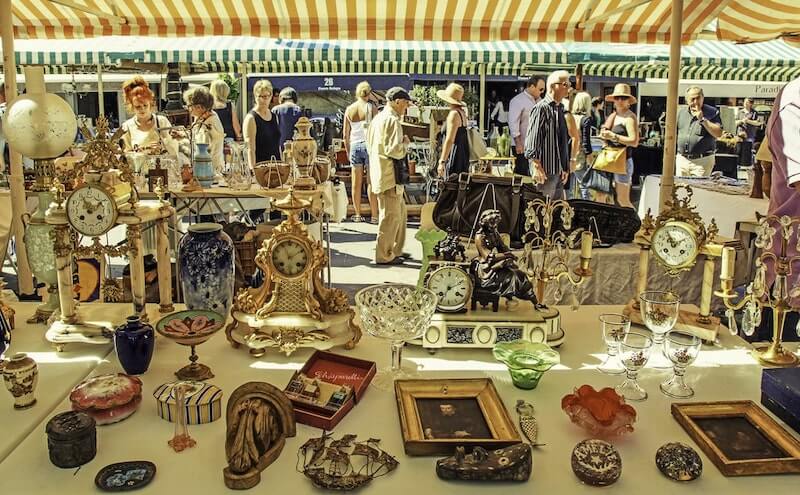 Aren't you just dying to get your hands on these bits and pieces and examine them more closely?
Aren't you just dying to get your hands on these bits and pieces and examine them more closely?The best brocantes (and other fairs) in France
We French love to debate, and antique fair markets are a good a topic as any. A pleasant half hour can easily be spent in a café arguing about which is the best French flea market, or the biggest, or has the best bargains and in true French style, we will rarely agree. Not that it matters.
I have my own favorites: the St Ouen Paris flea market, l'Isle sur la Sorgue in Provence, and the Puces du Canal in Lyon. I'll tell you about those below, which compare favourably with the best flea markets in Europe.
I also have aspirational brocantes, where I've never been but which are on my list, foremost being the Grande Braderie de Lille and the brocante de Chambord, held on the grounds of the castle of the same name. Let's take a look at some of these too.
Best flea markets in Paris? I'd head straight for Saint Ouen
The reason I suggest starting with Puces de St Ouen flea market is because it is the largest in France – no, wait, in the world, so once you're inside there's every chance you won't make it out until the shutters come down. Not that you'd want to.
It's not even a single antique market but 12 (or 15, depending on the source) distinct ones, covering seven hectares. This is where you'll find bizarre objects and vintage furniture, Asian art and formal French antiques, futuristic space artefacts and vintage clothing (the real stuff, not make-believe vintage made in Asia and chemically aged).
St Ouen is more museum than shopping arcade, its treasures stuffed in a warren of alleys and passageways you may never find your way out of. The map below will give you an idea of its size and many markets.
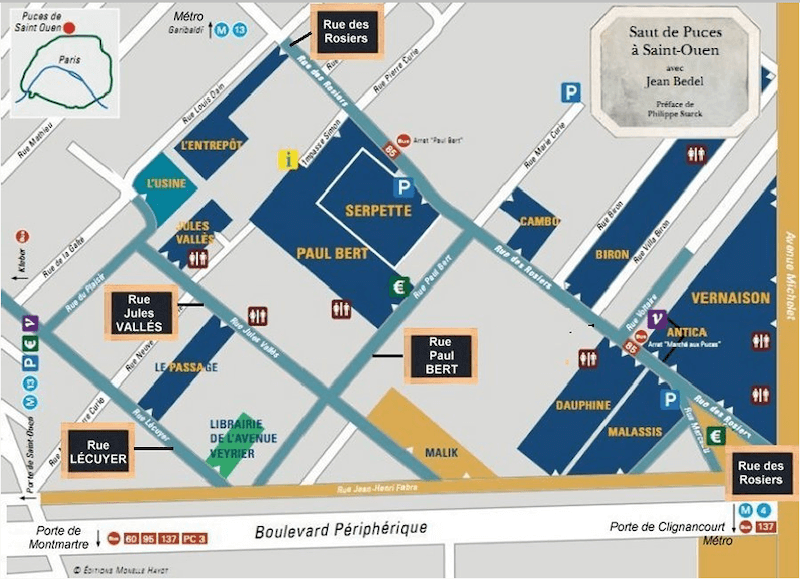
If you happen to visit the Vernaison market (the oldest and most charming, in my opinion) around lunchtime, head for Chez Louisette for typical French fare that hasn't changed in nearly a century. And accordion music. Yes, you'll find some tourists here but you can also eavesdrop on chatter about antiques because the authentic clientele doesn't seem to have left.
Historically inclined? Here's an intriguing look at how St Ouen market came to be.
L’Isle-sur-la-Sorgue
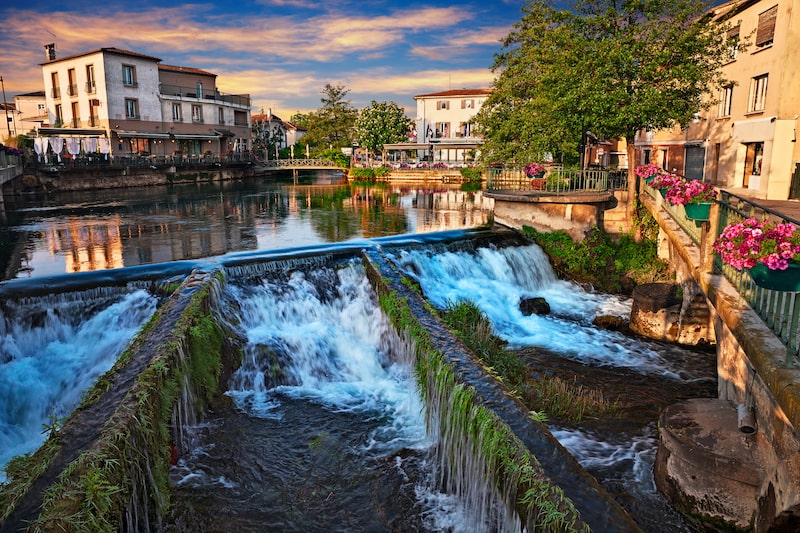 This photo may be excessively saturated but the odd colours haven't succeeded in spoiling the beauty of this village or dampening my desire to return, soon
This photo may be excessively saturated but the odd colours haven't succeeded in spoiling the beauty of this village or dampening my desire to return, soonIsle-sur-la-Sorgue, a half-hour drive from Avignon, calls itself France's capital of antiques, and I won't begrudge that self-proclaimed title because this is truly the perfect setting for anyone in love with old things.
It also happens to be larger than St Ouen (hard to imagine) and Europe's largest concentration of antique dealers: some 300 antique shops, open most of the year, with one antique dealer for every 70 residents.
Located on the Sorgue River, this adorable village in Provence becomes antiques central twice a year, on Easter Weekend and 15 August, so in prime holiday time. I prefer Easter, when the weather is more bearable. Antique markets at the height of summer in Provence is more punishment than I'm willing to take, but these events place the town in third place on the antiquing trail, second only to London and Paris.
The town's relationship with antiques dates back to 1890, when Joseph Légier set up shop here. The family history has them moving around but Joseph's grandson, René, co-organized the first antiques fair in 1966 with another gentleman called Albert Gassier. The modest fair showcased 14 merchants but some journalists heard about it and next thing you know, crowds arrived and it was a resounding success. And grew from there. The small farming and fishing town of Isle-sur-la-Sorgue would never be the same.
If you ever visit, I stayed at the delightful Maison sur la Sorgue...
The Grande Brocante de Chambord
Should you manage to find yourself visiting the Loire Valley chateaux around 1 May (May Day is one of France's statutory holidays), the Grande Brocante at Chambord, with its 500+ stands, is considered an essential stop. I've been to Chambord often enough to know that using this extraordinary chateau – the Loire Valley's largest – as a backdrop for a jumble sale is somewhat far-fetched. And yet...
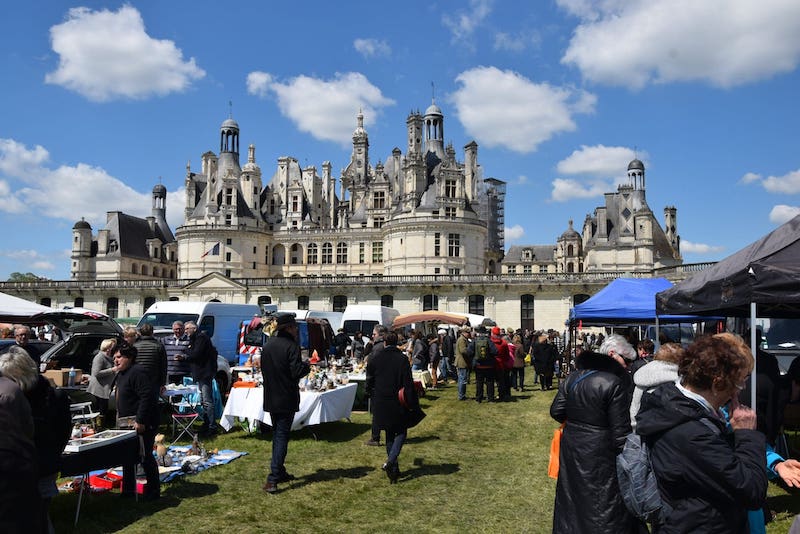
Built in Europe's biggest enclosed forest (and above marshland) by François I, Chambord was first imagined as a hunting lodge, designed to impress visiting royalty, and eventually finished more than a century after it was started.
Try to picture it before the lawns and gardens, teeming with wildlife, surrounded by swamps sucking away at the shoes and long dresses pushing through the muddy lands...
But best of all, go shopping. This is a quality brocante, with plenty of excellent wares for sale. It will take the better part of a day to see it all so come early, wear good shoes and bring your mosquito spray – Chambord is after all built over marshes. Chambord isn't hard to get to - you can drive from Paris (two hours) or take the train to Blois, and the half-hourly (in summer) shuttle to the chateau.
Lyon flea market (Les Puces du Canal)
Next time you visit Lyon, try to get yourself to this weekly brocante.
The biggest challenge is actually finding it – a few false exits around the périphérique ring road, a busy overpass, followed by winding around a suburb and under a bridge may be painful, but the pain is temporary, since you'll eventually end up at the delightful Puces du Canal.
It's not huge, certainly not on the scale of St Ouen or Isle-sur-la-Sorgue, but this is a robust brocante, one with a long history and plenty of fantastic items. Those Lyonnais know their antiques and this one is stuffed with authenticity.
This is the place for good design, much of it vintage and retro, a mixture of furniture and decor and one of my favourite weekend brocantes. Just have a look at some of what they sell... and do make sure you book a table for lunch at one its traditional eateries. Good news: there's an indoor section, if the rain starts pelting.
Oh, and you CAN get here on public transport if you live in Lyon. Just don't fall in love with a massive oak cupboard...
 An example of what you might find in an antique and flea market, Lyon in this case
An example of what you might find in an antique and flea market, Lyon in this caseA short history of French antique fairs and brocantes
The brocante as we know it dates back only a few centuries, but trading in used goods is as old as the hills – or Antiquity, at least.
History has records of second-hand trade among Egyptians, Greeks and Romans.
In the Middle Ages, wannabe crusaders in search of a war chest sold off their possessions, often from a cart but, increasingly, from tables set along certain streets.
These tended to be messy affairs. Markets were held in city centers and mostly sold rags or old clothes recycled by sellers. You can imagine the lack of hygiene in those days made the clothes not only pungent but held out the welcome mat for fleas.
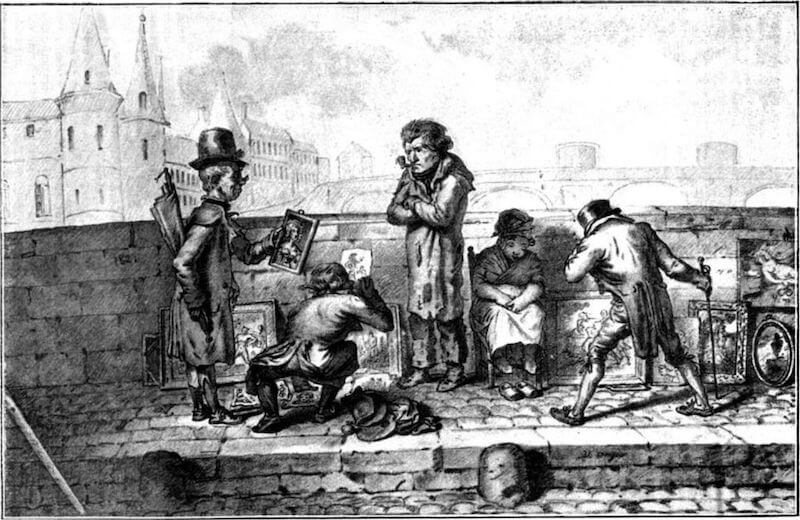 A flea market (Paris, France) once upon a time
A flea market (Paris, France) once upon a timeSlowly, things improved.
Cardinal Richelieu, conscious of the degrading dirt of these markets, moved the city markets to the suburbs. Eventually, Louis XIV, who was much into management and control over what went on in his state, started regulating such things as provenance and cost and by the 18th century, fear of counterfeit items pushed the selling of antiques into a bona fide profession, with rules and responsibilities and taxes.
Then came the French Revolution, where nobles lost not only their heads but their furniture, and the everyday Frenchman (or woman) could now afford to buy cast-off chateau furnishings and trinkets.
In Paris, the most famous markets are relatively recent. St Ouen only dates back to 1885, when people gathered near the Porte de Clignancourt to sell worthless goods, but after World War I, the market scene improved, with regular schedules and more permanent stands.
Today's garage sales, known as vide-greniers, are relatively recent. Dwellings are becoming smaller (who can afford the upkeep on an ancestral manor house?) and younger generations, often less attached to the trappings of lineage, are happy to unload those bulky family heirlooms.
While we French may seem a bit snooty and snobbish, we hold no grudge against recycling and like nothing better than sniffing out a good bargain at a neighbourhood brocante.
France flea markets: what's this about fleas?
The term flea market is actually claimed by several quarters.
The most common is that it comes from the French marché aux puces, 'market of the fleas'. You can probably guess why...
Many years ago, when much of the world was poor and before running water and an understanding of modern medicine, fleas were abundant and people didn't wash often. So when they sold off their clothes or house wares, these might not be quite clean... hence, "the market where everything comes with fleas."
The Dutch in New Amsterdam also lay claim to the word through their market, or vlie, the Dutch word for swamp, which is where the market was located. Add some Anglo-Saxon mispronunciation, change it to 'flea' and there you have it.
Bottom line: we don't know.
Definitions of a flea market in France
Adding to the confusion is the slight differentiation between the brocantes in France and the many other fairs and markets held on weekends where you can buy second-hand goods.
Here's a short, incomplete primer of what's what in the world of French flea markets.
- Vide-grenier: The equivalent of the garage sale, this is at the amateur end of the spectrum and is something most towns hold at least once a year. Individuals can rent a table and spread out their outdated blenders and grandmother's postcards.
- Brocante: The quintessential flea market, filled with second-hand goods at the lower end of the price scale. Although a brocante can at times sell quite valuable antiques, these will not be of the same quality as items you find in a proper French antique shop. These tend to be run by professionals who spend the summer months laying out their goods every weekend. Some do this for a full-time living, others as a weekend passion or side hustle.
- Marché aux puces: Another name for flea market and one that often combines a brocante with second-hand clothes.
- Farfouille: Comes from the verb farfouiller, to rummage. So, a rummage sale, a bit of everything.
- Braderie: From the verb brader, "to get rid of something for very little", this is a clearance where individuals can sell pretty much anything used from their homes.
- Foire: Usually a big affair, this 'fair' tends to take place in a specific place, once or twice a year, on set dates. It's something to look forward to each year. My own village has one and I wouldn't miss it for anything. There be cows and chickens! Along with excited PA systems hawking the latest automatic broom or finger-safe slicer (usually hawked by men whose broom and slicer experience is limited)
- Antiquités: this is a sign you'll mostly see atop a reputable shop selling French antiques. It will usually be owned by someone with education, a knowledge and love of history, and an eclectic collection of often unaffordable period delights.
Now please note that while these definitions tend to be correct, they are often used interchangeably. So if you see the sign 'brocante', you might actually be heading to a vide-grenier or a braderie.
Your best path to success is to find out how many 'exposants', or sellers, a particular event has. Anything over 50, in my book, is worth visiting if it's nearby, but if I have to drive for a bit, I'll look for at least 150 sellers. And I'll check the weather, because at the sight of rain that 150 could easily shrink by half.
Two more words you might want to know:
- chiner: to hunt for bargains, as in what we love to do on weekends
- marchander: to bargain, to haggle...
 Irrefutable evidence that there are cows in my village market in France (there is also a lot of junk, so I won't show you that)
Irrefutable evidence that there are cows in my village market in France (there is also a lot of junk, so I won't show you that)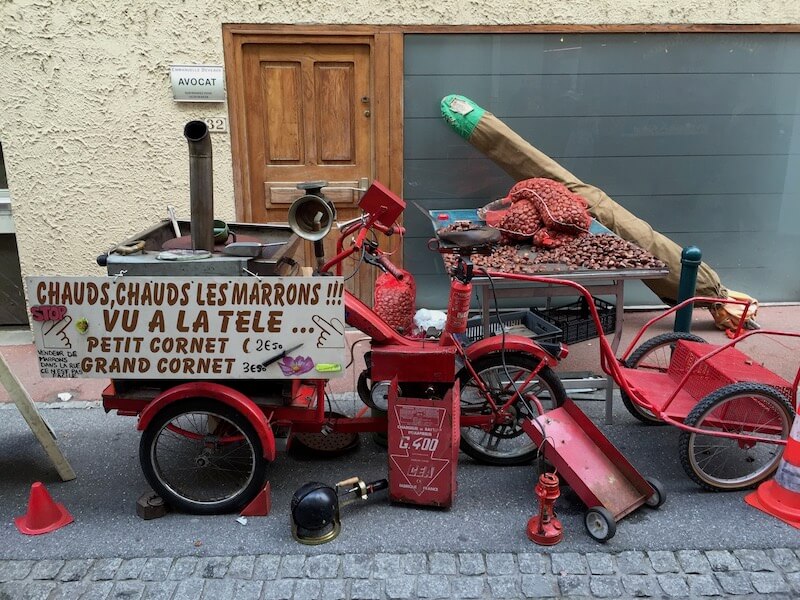 Chestnuts are much beloved in France, especially in autumn, and my local fair is on 11 November. The chestnut making machine (I have no idea how the chestnuts are transformed in this contraption) is on hand, but the chestnut machine operator is not
Chestnuts are much beloved in France, especially in autumn, and my local fair is on 11 November. The chestnut making machine (I have no idea how the chestnuts are transformed in this contraption) is on hand, but the chestnut machine operator is notAnnecy Old Town flea market
This is one of my favourite little flea markets, in part for what it sells – everything from cow bells to old wooden skis and bindings – but mostly because of the setting.
If you've ever been to Annecy, you'll understand why people elbow one another to visit this gorgeous town on the edge of a crystal lake, surrounded by scenic mountains. And if I sound like a travel brochure, it's because Annecy is that beautiful.
The brocante is monthly but its location in the old down, right under the 16th-century arcades, gives it a local market feel.
Annecy is two-plus hours from Lyon by train or half an hour's drive from Geneva – and should be on any Savoy or alpine itinerary.
It is a foodie city and the restaurants are right there, all around the brocante, so do yourself a favour and reserve your table.
In winter, this is the land of cheese – fondue, raclette (melted cheese) and tartiflette (a luscious combination of reblochon cheese, bacon, cream, onions and potatoes). Or you can stuff yourself with local specialties, some of which are on display or in many of the shops hidden under the arcades.
I should point out that at the end of the antiques market, hidden in a modern building on Place Georges Volland, is Rigollot, a pastry shop managed by a former Best Pastry Chef of France.
Just saying. If you need a break.
Nice antique market - Cours Saleya
My final personal favourite is Nice, on the Riviera (which we call the Côte d'Azur), where the gentle bay and near-eternal sunshine provide just the right atmosphere for hours of treasure hunting.
Because of the mixture of people who live in this region, the antiques and other goodies are varied, often with an Italian flavour, or things descended from the Alps beyond. You'll find everything here, from jewellery to furniture and art and it feels welcoming, almost lulling you into a complacency you'll only snap out of when you realize just how much you're carrying and how much you've bought.
I love that this market takes places on Mondays, when much of France is closed for business and it's always hard to find something to do.
Not only will you find great buys, but it's the perfect people-watching spot. And this might be a good place to mention it's right near the antiques district, in case you feel like parting ways with even more cash... or just to take a look because you will be delighted.
The flea market is crowded though, and like everywhere crowds gather to spend money, hands are busy stretching out to grab some of that money, so be careful with your purse or it'll be gone by the time you pull it out to pay for that piece of porcelain so perfect for your wall unit.
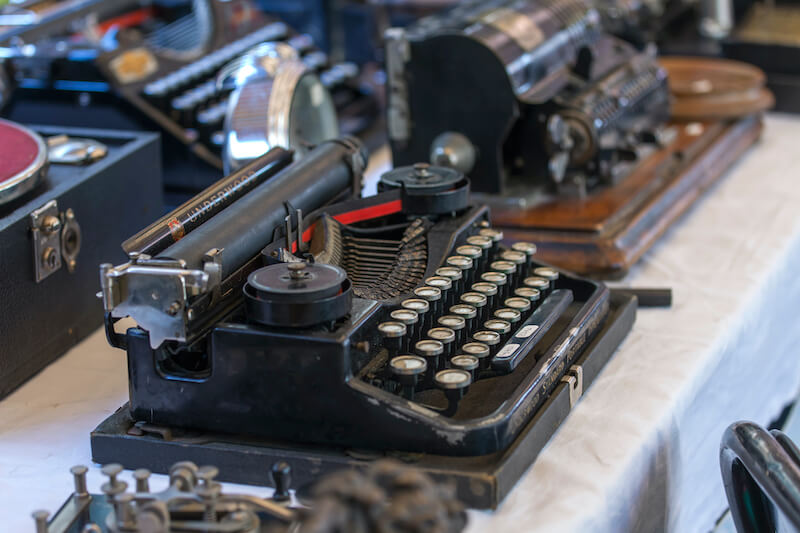 A sample of what you can expect to find in an antique market (Nice, France)
A sample of what you can expect to find in an antique market (Nice, France)Other highly recommended antique markets in France
Above are my favourites but there are others which make it onto every list of 'bests' and 'Top 10s'. I may not know them personally, but they come highly recommended by hundreds who do.
- Montreuil Flea Market, Paris - one of the city's oldest and good for vintage fashion
- La Grande Braderie de Lille, or Lille market in Northern France, in early September, Europe's largest with some 10000 sellers; and dates back to medieval times (first mentioned in 1127) - the atmosphere looks fabulous! Not to mention that Lille is worth visiting...
- Brocante de Maroilles, in the second half of June, one of the top (maybe the top) antique fairs in northern France – only professional antique dealers can sell here so everything should be authentic
- Orléans, in the historic Loire Valley, more rustic than antique but it's a lovely city
- Brocante Saint Aubin in Toulouse, one of the southwest's oldest
- The monthly brocante at Arles and weekly Avignon flea market, great excuses to visit these two stunning cities in Provence
How to prepare for your brocante vintage market experience
You don't just walk out of your house on a Sunday morning with a vague memory of a sign you saw on the boulangerie wall... No. Preparing properly for a brocante requires a little forethought.
Here are a few steps that should provide you with a foolproof experience:
- Make sure you know where it is. I once circled Lyon for an hour looking for les Puces du Canal (it was worth the extra time!) but get that village's name into your GPS and make sure the brocante is actually taking place. Things happen, things get cancelled...
- Decide what you're shopping for. Of course you'll walk away with things you never planned to buy but you might ALSO find something you actually want (or even need). Don't forget your measuring tape...
- Choose your wardrobe – and no, I'm not being precious. A brocante is a serious thing, and some of us manage two or even three in a single day. That means incredibly comfortable shoes, and weather-appropriate clothing. You don't want to rush for cover at the first few drops (and bear in mind that rain is your friend - sellers will want to head home before their stock gets wet and this might be your chance for a bargain). And do leave the bling at home if you're planning to bargain; those gold earrings will only mean one thing to a seller: charge this one more!
- Go to the bank and get some cash, because unless you have a fat wad of bills (or sometimes a checkbook) you'll go home empty-handed. No cards are accepted, except in the rare case the stand belongs to someone who also has a shop somewhere, with a physical address and a bank machine.
- Don't take the bus if you have a car or van. It might be tempting to forgo the parking lot madness but think about it. What if you find that 1960s hanging lamp you never thought you'd see again? How do you fit that on the bus. No, let's be sensible. Bring a van. Rent one for the day if you don't have one. Then you'll have an excuse to fill it up.
- Find out when merchants actually arrive. First thing in the morning (sometimes as early as 4am), they'll start unloading their vans, often having slept in them. This moment is called the déballage, the unpacking, and is when professionals swoop in like hungry birds, scooping up every worthwhile item in sight. If you want to see the choice pieces (but you will pay top price) then set your alarm clock. But check first, because in some cases, the first few hours of the morning are reserved for professionals of the trade.
- Always, always bargain, unless the stand clearly belongs to a shop and every item has a price sticker on it. Even then, I'd try... "Un tout petit geste, s'il vous plaît?" Just a little gesture, please? This is always done with a smile, with courtesy, and with a friendly parting of the ways if no agreement is reached.
- Before you buy, turn your object over, around, upside down. I'm serious. I have a lovely vintage lamp with 150 hanging pieces. Actually, 148 pieces. Because I didn't look carefully enough. Of course I only saw that when I got home, hours later...
- Take advantage of the moment. If language permits, talk to the seller, find out about an object's history, who owned it, why it ended up here. Then you'll have stories to tell when everyone else admires your purchase.
What sells at a brocante: French flea market finds
My house is filled with useless purchases, beautiful, useless purchases, because who needs three Art Deco mantlepiece clocks that don't work, especially when you don't have a mantlepiece...
The fact that they found their way into my home goes to show you how diverse the offerings can be. Walking down a typical brocante, here's what I see: an antique door, a stuffed reindeer head, walking canes with silver handles, a 1922 guidebook to Chamonix, old vinyl records (although it's nearly 40℃ outside right now and I suspect they've taken on a bit of a wave), a bowl with old stones, an incomplete set of silver spoons, a postcard collection, a plastic Mickey Mouse doll, a stack of old wine packing crates, some heirloom brooches – and my potentially FOURTH mantlepiece Art Deco clock...
Often, the best-selling items at a flea market are those you can carry home or fit into your car, because not everyone comes equipped with a double-length van.
Whatever you're looking for, you'll probably find. You may have to spend a few summer weekends out and about, it might cost more than you'd budgeted, but you WILL find it. Be persistent!
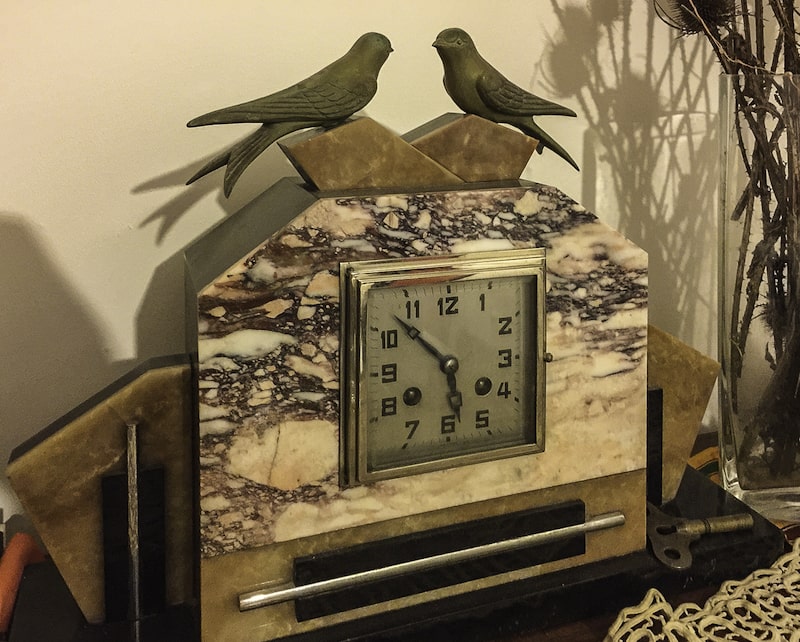 Art Deco clock #3. Now you understand why I couldn't resist...
Art Deco clock #3. Now you understand why I couldn't resist...How to bargain like a pro at your local French antique market
Bargaining is part of the game at these affairs and knowing a few rules will help you not only get a better price, but also have more fun.
While you'll find much more variety for sale early in the morning, that's also when you'll pay the highest prices. By the end of the day, sellers want to get rid of as much as possible and close their day on a positive note, so your chances of a bargain are greater.
Ask if this is their 'meilleur prix'? Dernier prix? Is this your best price? Your last price?
Bear in mind that you should be able to bring the original asking price down by 20-30%. If your purchase is a major one, an antique or serious vintage piece, for example, you could always try to find something comparable online to check the going price. I never do. It would take away all the fun!
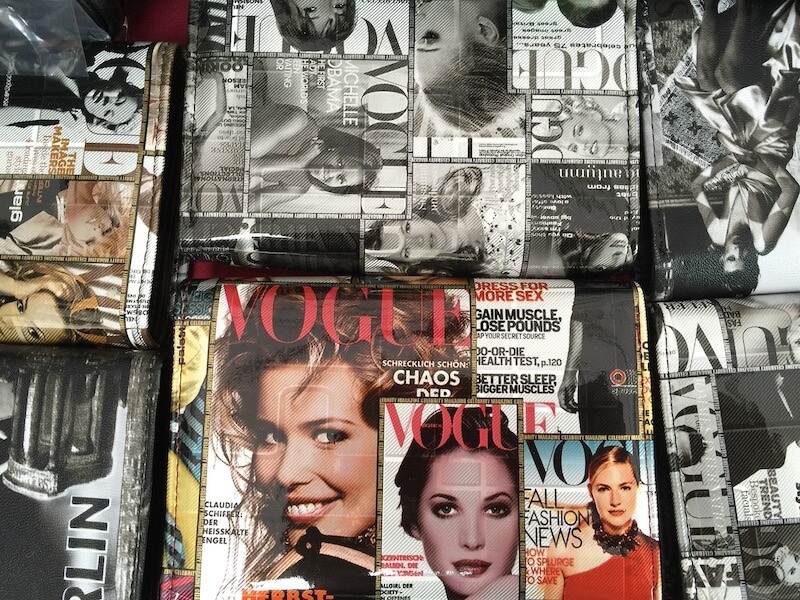 You never know what you're going to find in a brocante market (France)
You never know what you're going to find in a brocante market (France)Finding the best France antiques near you
Finding a brocante in France in summer is about as difficult as spotting a baguette in a boulangerie.
Here are just a few of the places you can search to find out what's happening in your corner of France:
- local newspapers, of course
- antique magazines (you'll find this and the above in any tobacco or 'presse' shop)
- With 50,000-plus brocantes taking place each year in France, how on earth do you choose? However lost you may be somewhere in the French countryside on a summer weekend, there is bound to be a brocante nearby, probably several.
- Calendrier des Brocantes, a practical web-based list by département
- Petit Futé, a slightly more curated list, in English
There is also a growing trend of French flea markets online: Many new professionals are younger and tech-savvy, and the cost of renting a stand for the day can be high in the better brocantes so selling online can cut overheads.
If an online outing is your preference, and it is not mine, here are a few places you'll be able to find brocante items without leaving the security of your sofa:
- eBay France, of course
- Le Bon Coin, for classifieds
- Selency, an online community marketplace of brocante buyers and sellers (and in English!)
Some brocanteurs have met modernization halfway and shifted part of their activities online, where they can earn extra money but still maintain their presence on the ground, an acceptable compromise.
Still, this is development I resist. If you need a specific item or if time is an issue, there's nothing wrong with ordering online.
But if you're looking for treasure, you need to walk along many stalls, rain or sunshine, clutching your cash and sharpening your eyesight. Nothing about this delightful adventure can be replaced by a website and for me, visiting a brocante online is about as exciting as choosing the right masking tape.
A brocante is all about social interaction, about rummaging through a hundred stands under the hot summer sun, arguing (politely) with the seller, finding out that he's been on this same spot every third Sunday in July for the past 60 years... those are the traditions France is made of and that I hope we never lose.
Did you enjoy this article? I'd love if you shared it!
 |
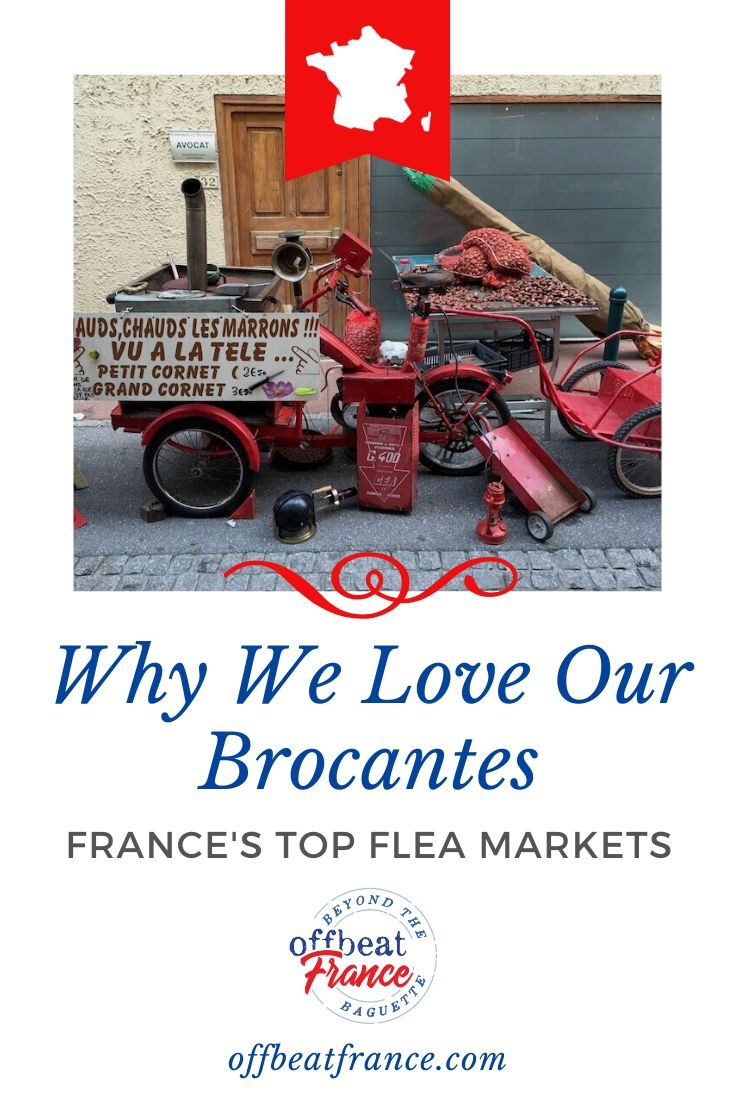 |

